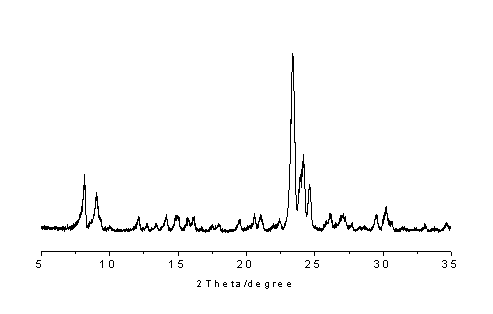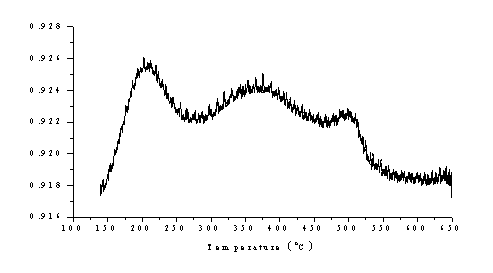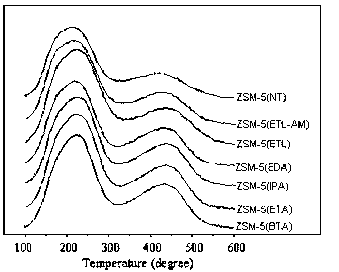Gradient acid distributed ZSM-5 molecular sieve and preparation method thereof
A technology of ZSM-5 and molecular sieve, which is applied in the direction of crystalline aluminosilicate zeolite, borocarbane silicone crystalline aluminosilicate zeolite, etc., can solve the problems that the acid properties cannot meet its needs and the shape-selective properties cannot be applied, etc. To achieve the effect of highlighting the reaction effect
- Summary
- Abstract
- Description
- Claims
- Application Information
AI Technical Summary
Problems solved by technology
Method used
Image
Examples
Embodiment approach 1
[0020] In the first step, add 1.6g of sodium hydroxide and 1.2g of aluminum sulfate to 140ml of deionized water respectively, weigh 7.5g of tetrapropylammonium bromide and add it to the solution, stir for half an hour, add 15ml of silica sol, and stir evenly , put into a stainless steel crystallization kettle, crystallize at a constant temperature of 180°C for 12 hours, and then cool to room temperature.
[0021] Synthetic raw material ratio: Al 2 o 3 :50SiO2 2 :15.6 TPA + :11.1Na 2 O:4700H 2 o
[0022] The second step is to stir the cooled mixture after crystallization. After stirring evenly, add 1.2g of aluminum sulfate directly, then stir for 2.0h, put it into a stainless steel crystallization kettle, and crystallize at a constant temperature of 180°C for 18 hours, then cool to room temperature , washed, dried and calcined to obtain ZSM-5 molecular sieve.
Embodiment approach 2
[0024] In the first step, add 1.8g of sodium hydroxide and 1.2g of aluminum sulfate to 120ml of deionized water respectively, weigh 7.5g of tetrapropylammonium bromide and add it to the solution, stir for half an hour, add 20ml of silica sol, and stir evenly , put into a stainless steel crystallization kettle, crystallize at a constant temperature of 180°C for 18 hours, and then cool to room temperature.
[0025] Synthetic raw material ratio: Al 2 o 3 :67SiO2 2 :15.6 TPA + :12.5Na 2 O:4222H 2 o
[0026] The second step is to stir the cooled mixture after crystallization. After stirring evenly, add 0.5g of aluminum nitrate directly, then stir for 2.0h, put it into a stainless steel crystallization kettle, crystallize at a constant temperature of 140°C for 24 hours, and then cool to room temperature , washed, dried and calcined to obtain ZSM-5 molecular sieve.
Embodiment approach 3
[0028] In the first step, add 1.6g of sodium hydroxide and 1.2g of aluminum sulfate to 150ml of deionized water respectively, weigh 10g of tetrapropylammonium bromide and add it to the solution, stir for half an hour, add 25ml of silica sol, and stir evenly. Put it into a stainless steel crystallization kettle, crystallize at a constant temperature of 140°C for 48 hours, and then cool to room temperature.
[0029] Synthetic raw material ratio: Al 2 o 3 :83SiO2 2 :20.8 TPA + :11.1Na 2 O:5277H 2 o
[0030] The second step is to stir the cooled mixture after crystallization. After stirring evenly, add 1.2g of aluminum sulfate directly, then stir for 2.0h, put it into a stainless steel crystallization kettle, and crystallize at a constant temperature of 180°C for 18 hours, then cool to room temperature , washed, dried and calcined to obtain ZSM-5 molecular sieve.
PUM
 Login to View More
Login to View More Abstract
Description
Claims
Application Information
 Login to View More
Login to View More - R&D
- Intellectual Property
- Life Sciences
- Materials
- Tech Scout
- Unparalleled Data Quality
- Higher Quality Content
- 60% Fewer Hallucinations
Browse by: Latest US Patents, China's latest patents, Technical Efficacy Thesaurus, Application Domain, Technology Topic, Popular Technical Reports.
© 2025 PatSnap. All rights reserved.Legal|Privacy policy|Modern Slavery Act Transparency Statement|Sitemap|About US| Contact US: help@patsnap.com



